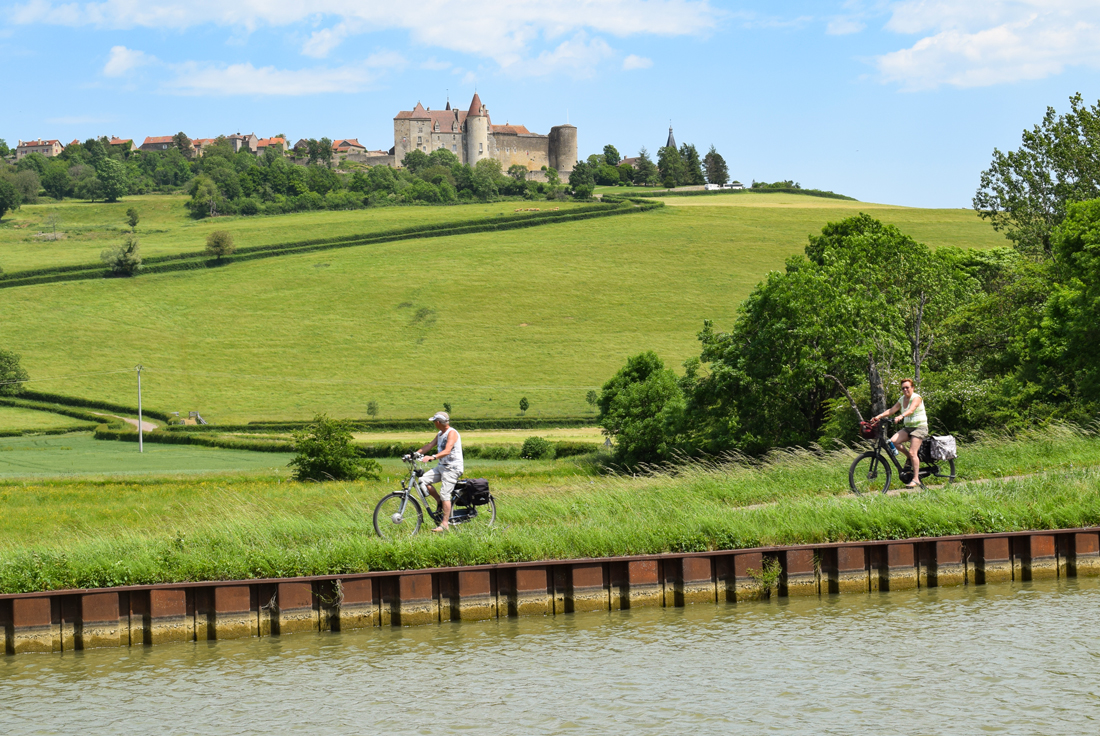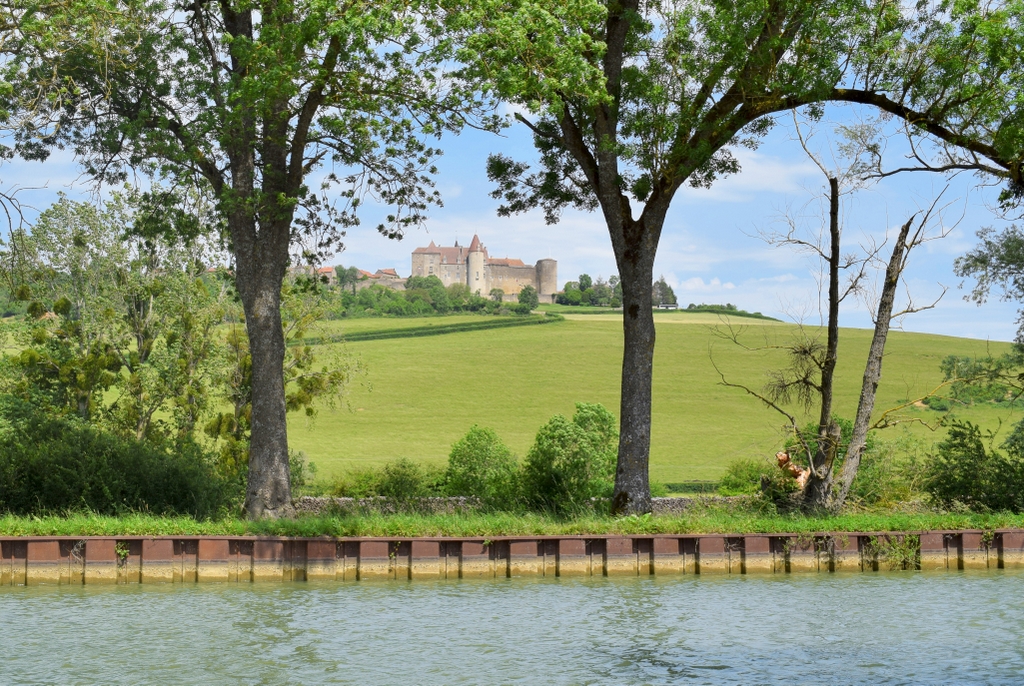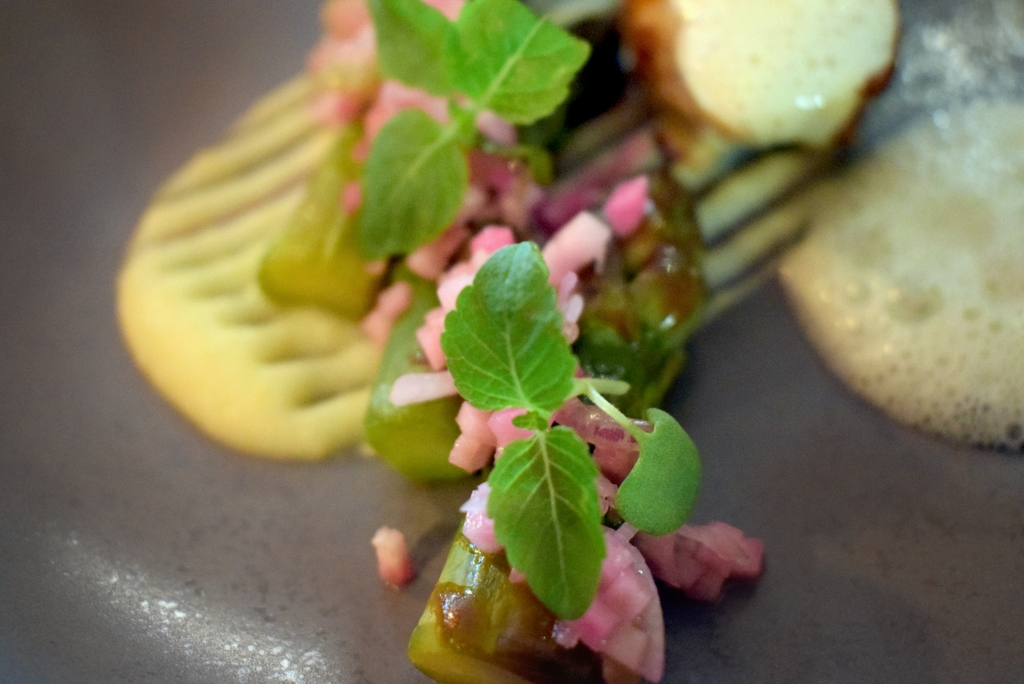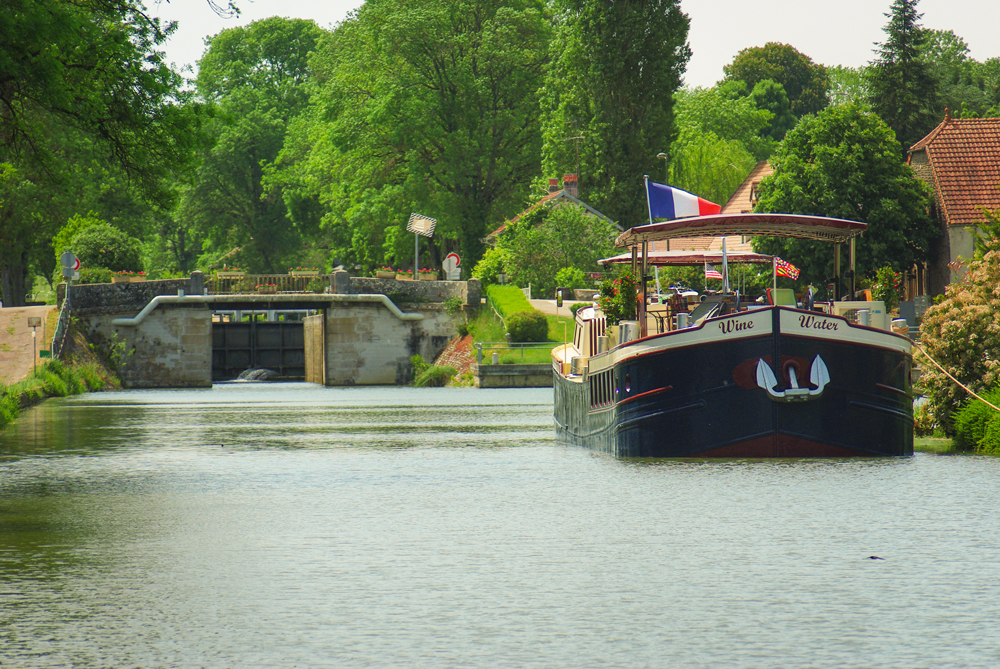It is said that Burgundy is like a snail. It will not reveal anything to the hurried tourists who rush through the region without taking the time to stop. The region will be content to shut itself up in its shell. But if you know how to approach it and appreciate it at its true value, Burgundy will open its heart to you. One of the best ways to discover the region is to sail on the canal de Bourgogne (or Burgundy canal).
Indeed, Burgundy is the leading river region in France. Among the canals and waterways of France, the Burgundy Canal is one of the most popular with tourists. Hire a houseboat and enjoy the scenery: bucolic landscapes, fortified villages and towns of character! Come on, let’s take a trip along the water through the Yonne and the Côte d’Or.
What is the Canal de Bourgogne or Burgundy canal?
The Canal de Bourgogne (or Canal of Bourgogne or Burgundy Canal) is 242 km long and links the Seine and Rhône basins.
The small-gauge waterway thus crosses the watershed between the English Channel and the Mediterranean Sea.
As its name suggests, the canal runs exclusively through the historic province of Burgundy and more specifically through the départements of Yonne [89] and Côte d’Or [21].
The construction of the canal dates back to 1775 and the inauguration took place in 1832. The waterway was intended to improve the transport of goods between Paris, Lyon and Marseille.
However, it soon came into direct competition with the railways and the car.
![The marina of the Canal de Bourgogne at Tanlay © Pline - licence [CC BY-SA 3.0] from Wikimedia Commons](https://frenchmoments.eu/wp-content/uploads/2022/02/Tanlay-Port-de-Plaisance-©-Pline-licence-CC-BY-SA-3.0-from-Wikimedia-Commons-scaled.jpg)
From now on, the Burgundy Canal is almost exclusively allocated to pleasure boating, to the delight of boaters.
![Route of the Burgundy Canal © PRA - licence [CC BY-SA 4.0] from Wikimedia Commons](https://frenchmoments.eu/wp-content/uploads/2022/02/Tracé-du-Canal-de-Bourgogne-©-PRA-licence-CC-BY-SA-4.0-from-Wikimedia-Commons.png)
Description of the Burgundy Canal
- Inauguration date: 1832
- Starting point: Migennes, watered by the Yonne, a tributary of the Seine – altitude 83 metres.
- Arrival point: Saint-Jean-de-Losne, on the banks of the Saône, a tributary of the Rhône – altitude: 182 metres
- Length of the canal: 242 km
- Direction of the route: north-east/south-east axis, except to the east of Dijon where the canal follows the Ouche, making a large hook towards the north-east.
- Towns and villages crossed: Saint-Florentin, Tonnerre, Montbard, Pouilly-en-Auxois and Dijon
- Number of locks: 189 (113 on the Yonne side and 76 on the Saône side)
- 1 long tunnel of 3.3 km at Pouilly-en-Auxois crossing the watershed between the Channel and the Mediterranean – altitude 378 metres.
- 5 canal bridges, the most important of which is at Saint-Florentin and crosses the Armance, a tributary of the Armançon.
- 43 port calls (ports and/or water stations)

The cycle route along the Canal of Bourgogne
Thanks in part to the existence of canals, Burgundy offers a vast network of greenways to cycle along.
The cycle route that crisscrosses the countryside of the Yonne and Côte d’Or regions follows the towpath of the Canal of Bourgogne. The cycle route covers more than 227 kilometres from Migennes to Dijon.

Navigating on the Canal de Bourgogne
Some practical advice for exploring the most beautiful sites along your Burgundy Canal cruise:
- Barge hire is available by the day, weekend or week. Houseboats (or barges) are subject to booking conditions (rental period, departure days, etc.) which may differ according to the season.
- Most of the time, boats are rented without an accompanying pilot. No boat licence is required as the control lever has only two positions. However, you must be of age. The yachtsman will receive a theoretical lesson before setting off on the cruise. You will receive information on navigation: respecting speed limits, passing locks and how to dock.
- Take bicycles on board! You can use them to explore the area around your marina or simply cycle along the towpath!
- This list of the most beautiful sites is an inspiration for you to discover the region. Let yourself be surprised by other discoveries during your escapades and stay curious! There is so much to discover, especially if you are a lover of small heritage. Don’t hesitate to go to the tourist offices. The receptionists I met during my travels in Burgundy know the area and will be happy to help you discover their beautiful region.
- To find out more about the Burgundy canal (lock sites, water supply, bridges and footbridges, ports and water stations…)

Where to stop along the Burgundy canal?
The Canal of Bourgogne currently has 43 ports and/or water stations where you can stopover.

The most beautiful sites on the Canal de Bourgogne
Let’s get to the heart of the matter by starting the route in Migennes, north of Auxerre.
Migennes
Migennes is located at the confluence of the Armançon and the navigable Yonne (allowing you to reach Joigny or Auxerre by boat). The small shopping town is the starting point for the Burgundy Canal
![The Canal de Bourgogne at Migennes © Cabaret escale - licence [CC BY-SA 3.0] from Wikimedia Commons](https://frenchmoments.eu/wp-content/uploads/2022/02/Migennes-©-Cabaret-escale-licence-CC-BY-SA-3.0-from-Wikimedia-Commons.jpg)
Saint-Florentin
The town of Saint Florentin is set on a hill overlooking the confluence of the Armande and Armançon rivers. Its picturesque streets lead to the top of the hill.
![Saint-Florentin © Benjism89 - licence [CC BY-SA 3.0] from Wikimedia Commons](https://frenchmoments.eu/wp-content/uploads/2022/02/Saint-Florentin-©-Benjism89-licence-CC-BY-SA-3.0-from-Wikimedia-Commons.jpg)
This is where the late Gothic (early 16th century) church of Saint-Florentin stands. Inside is one of the few rood screens still in existence in France. Admire also the beautiful stained glass windows of the Champagne school (16th century) and remarkable statues of the 16th-17th centuries.
Another church, Saint-André d’Avrolles, dates from the 12th century (reworked in the 16th century).
![Saint-André d'Avrolles church © Oblomov2 - licence [CC0] from Wikimedia Commons](https://frenchmoments.eu/wp-content/uploads/2022/02/Eglise-Saint-André-dAvrolles-©-Oblomov2-licence-CC0-from-Wikimedia-Commons-scaled.jpg)
The terrace of the Promenade du Prieuré offers a beautiful view of the Armançon valley and the old town.
The bridge-canal of Saint-Florentin
The Saint-Florentin canal bridge allows the Burgundy canal to cross the Armance. It is a stone aqueduct with five arches, built in 1810. It is located near the Saint-Florentin marina, at lock 108.
![The bridge-canal of Saint Florentin © Pline - licence [CC BY-SA 3.0] from Wikimedia Commons](https://frenchmoments.eu/wp-content/uploads/2022/02/Pont-canal-Saint-Florentin-©-Pline-licence-CC-BY-SA-3.0-from-Wikimedia-Commons-scaled.jpg)
Before leaving the town, don’t forget to taste the two local pieces of cheese: Saint-Florentin and Soumaintrain.
Dannemoine
The church of Notre-Dame de Dannemoine dates back to the 12th century. Its Romanesque portal is dominated by a powerful square bell tower. Inside, the Renaissance choir dates from the 16th century.
![Dannemoine church © Leseb - licence [CC BY-SA 3.0] from Wikimedia Commons](https://frenchmoments.eu/wp-content/uploads/2022/02/Dannemoine-©-Leseb-licence-CC-BY-SA-3.0-from-Wikimedia-Commons-scaled.jpg)
The village is also home to a 12th-century wine press and an 1877 wash house with a roof supported by 12 cast-iron posts.
The culinary speciality of Dannemoine is the Burgundy snail (escargot de Bourgogne).
Tonnerre
Don’t let its name – Tonnerre (Thunder) fool you! Tonnerre is a small town of character surrounded by vineyards and greenery. The old town is set on a hill overlooking the Armançon valley. The imposing Saint-Pierre church dominates the site. From the Saint-Pierre terrace, there is a beautiful view of the town and its valley.
![Saint-Pierre de Tonnerre church © Espirat - licence [CC BY-SA 4.0] from Wikimedia Commons](https://frenchmoments.eu/wp-content/uploads/2022/02/Tonnerre-Eglise-Saint-Pierre-©-Espirat-licence-CC-BY-SA-4.0-from-Wikimedia-Commons-scaled.jpg)
The Old Hospital (Hôtel-Dieu) is worth a visit. Built between 1293 and 1295 by Marguerite de Bourgogne, Countess of Tonnerre, it houses a large hall of impressive dimensions. The hospital church houses the tomb of the countess and a magnificent 15th-century tombstone.
![Hôtel-Dieu Notre-Dame des Fontenilles in Tonnerre © Espirat - licence [CC BY-SA 4.0] from Wikimedia Commons](https://frenchmoments.eu/wp-content/uploads/2022/02/Tonnerre-Hôtel-Dieu-Notre-Dame-des-Fontenilles-©-Espirat-licence-CC-BY-SA-4.0-from-Wikimedia-Commons-1.jpg)
Tonnerre is famous for its Vaucluse spring: the Fosse Dionne (Dionne pit). Built as a washhouse with a circular basin in the 18th century, the colour of its blue-green water contrasts with the red of the Burgundian tiles.
![La Fosse Dione © Pline - licence [CC BY-SA 3.0] from Wikimedia Commons](https://frenchmoments.eu/wp-content/uploads/2022/02/Tonnerre-Fosse-Dione-©-Pline-licence-CC-BY-SA-3.0-from-Wikimedia-Commons-scaled.jpg)
Tanlay
The castle of Tanlay is a magnificent renaissance style monument built around 1550. It belonged to the family of Admiral de Coligny, to the superintendent of finance Michel Particelli d’Émery (a close friend of Mazarin), before becoming the property of the Marquis de Tanlay at the end of the 17th century. It should be admired in the afternoon when the façade is lit by the sun.
![Tanlay castle © Pline - licence [CC BY-SA 3.0] from Wikimedia Commons](https://frenchmoments.eu/wp-content/uploads/2022/02/Château-de-Tanlay-©-Pline-licence-CC-BY-SA-3.0-from-Wikimedia-Commons-scaled.jpg)
Not far from there are the ruins of the Cistercian abbey of Quincy, founded in 1133 by monks from Pontigny Abbey.
![Canal de Bourgogne - Quincy Abbey © Pline - licence [CC BY-SA 3.0] from Wikimedia Commons](https://frenchmoments.eu/wp-content/uploads/2022/02/Abbaye-de-Quincy-©-Pline-licence-CC-BY-SA-3.0-from-Wikimedia-Commons-scaled.jpg)
A few kilometres south of Tanlay, the canal runs alongside the village of Saint-Vinnemer in a charming setting. The church of Saint-Vilmer (or Vinnemer) has a 13th-century Romanesque porch.
![The village of Saint Vinnemer on the canal de Bourgogne © Pline - licence [CC BY-SA 3.0] from Wikimedia Commons](https://frenchmoments.eu/wp-content/uploads/2022/02/Saint-Vinnemer-©-Pline-licence-CC-BY-SA-3.0-from-Wikimedia-Commons-scaled.jpg)
Ancy-le-Franc
The castle of Ancy-le-Franc is one of the most beautiful achievements of the Renaissance in Burgundy. Completed in 1546 by Antoine III de Clermont, brother-in-law of Diane de Poitiers, it passed into the hands of Louvois and his descendants in 1684.
![Canal de Bourgogne - The castle of Ancy-le-Franc © Christophe.Finot - licence [CC BY-SA 2.5] from Wikimedia Commons](https://frenchmoments.eu/wp-content/uploads/2022/02/Ancy-le-Franc-©-Christophe.Finot-licence-CC-BY-SA-2.5-from-Wikimedia-Commons-scaled.jpg)
The castle has four similar buildings connected by corner pavilions. This type of architecture is the first model of the classical Renaissance in France.
Before leaving Ancy-le-Franc, be sure to take a look at the old village washhouse (behind number 49 of the main street).
![The wash house of Ancy-le-Franc © PiJACHRETIEN - licence [CC BY-SA 4.0] from Wikimedia Commons](https://frenchmoments.eu/wp-content/uploads/2022/02/Ancy-le-Franc-Lavoir-©-PiJACHRETIEN-licence-CC-BY-SA-4.0-from-Wikimedia-Commons.jpg)
Nuits
Last stop before leaving the Yonne département: the village of Nuits-sur-Armançon.
![The castle of Nuits © Neaeris - licence [CC BY-SA 4.0] from Wikimedia Commons](https://frenchmoments.eu/wp-content/uploads/2022/02/Chateau-de-Nuits-©-Neaeris-licence-CC-BY-SA-4.0-from-Wikimedia-Commons.jpg)
Nuits was located on the ancient border between Burgundy and Champagne, which was marked by the Armançon River.
The castle of Nuits, built during the Wars of Religion, has retained an austere and defensive appearance (especially the eastern façade) despite the disappearance of its fortified enclosure.
In the village, two monumental ringed columns – the columns of Nuits – date from the 18th century. Nearby is the Porte Fortifiée de Nuits, a 16th-century town gate.
![Canal de Bourgogne - The columns and the fortified gate of Nuits © Myrabella - licence [CC BY-SA 4.0] from Wikimedia Commons](https://frenchmoments.eu/wp-content/uploads/2022/02/Nuits-Colonnes-et-porte-fortifiée-©-Myrabella-licence-CC-BY-SA-4.0-from-Wikimedia-Commons-scaled.jpg)
Rougemont
The entrance to the Côte d’Or département is in Rougemont, a small village whose church of the Nativity of Rougemont (former abbey church of Notre-Dame) dates from the 13th century.
The Buffon Forges
The impressive Buffon Forges date from 1768 and are situated in a beautiful green setting between the villages of Rougemont and Buffon. The great French naturalist Buffon wanted to have a forge to commercially exploit his discoveries on iron and steel. It also allowed him to continue his experiments on minerals on a large scale.
![Canal de Bourgogne - Buffon Forges © Marc Ryckaert - licence [CC BY-SA 4.0] from Wikimedia Commons](https://frenchmoments.eu/wp-content/uploads/2022/02/Forges-de-Buffon-©-Marc-Ryckaert-licence-CC-BY-SA-4.0-from-Wikimedia-Commons-scaled.jpg)
Montbard
An important stopover on a cruise on the Burgundy canal, the town of Montbard occupies the slopes of a hill on which the castle of Montbard (10th century) stands guard.
![Montbard and the Brenne © Pliny - licence [CC BY-SA 3.0] from Wikimedia Commons](https://frenchmoments.eu/wp-content/uploads/2022/02/Montbard-et-la-Brenne-©-Pline-licence-CC-BY-SA-3.0-from-Wikimedia-Commons-scaled.jpg)
The town of Montbard is the birthplace of the naturalist, biologist, philosopher and writer Buffon (1707-1788). He bought the ruined castle in 1735 to create the gardens that still bear his name.
![Canal de Bourgogne - Buffon Park and the Chateau of Montbard © Pline - licence [CC BY-SA 3.0] from Wikimedia Commons](https://frenchmoments.eu/wp-content/uploads/2022/02/Montbard-Parc-Buffon-et-Chateau-©-Pline-licence-CC-BY-SA-3.0-from-Wikimedia-Commons-scaled.jpg)
Fontenay Abbey
Five kilometres from Montbard is one of the most popular tourist sites in Burgundy: the magnificent Fontenay Abbey (abbaye de Fontenay).
This 12th-century Cistercian monastery has one of the oldest Cistercian churches preserved in France.
![Fontenay Abbey © Jean-Christophe BENOIST - licence [CC BY 2.5] from Wikimedia Commons](https://frenchmoments.eu/wp-content/uploads/2022/02/Abbaye-de-Fontenay-©-Jean-Christophe-BENOIST-licence-CC-BY-2.5-from-Wikimedia-Commons-scaled.jpg)
Alise-Sainte-Reine
Alise Sainte-Reine is a colourful site for those interested in the history of Ancient Times.
The village is situated against the Mont Auxois (407 metres) which separates the valleys of the Oze and the Ozerain.
![Mount Auxois and Alise-Sainte-Reine © Claire Jachymiak - licence [CC BY-SA 4.0] from Wikimedia Commons](https://frenchmoments.eu/wp-content/uploads/2022/02/Alise-Sainte-Reine-©-Claire-Jachymiak-licence-CC-BY-SA-4.0-from-Wikimedia-Commons.jpg)
This is the presumed site of the famous siege of Alesia where Julius Caesar’s Roman army and the Gallic coalition led by Vercingetorix clashed in 52 BC. At the foot of the hill is the MuseoParc Alesia, which opened in 2012.
![The MuseoParc Alesia © Marcel Roblin - licence [CC BY-SA 4.0] from Wikimedia Commons](https://frenchmoments.eu/wp-content/uploads/2022/02/MuseoParc-Alésia-©-Marcel-Roblin-licence-CC-BY-SA-4.0-from-Wikimedia-Commons-scaled.jpg)
![At the Museoparc d'Alésia © Arnaud 25 - licence [CC BY-SA 3.0] from Wikimedia Commons](https://frenchmoments.eu/wp-content/uploads/2022/02/Museoparc-Alésia-©-Arnaud-25-licence-CC-BY-SA-3.0-from-Wikimedia-Commons.jpg)
At the top of Mount Auxois, the monumental statue of Vercingetorix has stood since 1865, commissioned by Emperor Napoleon III to the sculptor Aimé Millet.
![The famous statue of Vercingetorix © Claire Jachymiak - licence [CC BY-SA 4.0] from Wikimedia Commons](https://frenchmoments.eu/wp-content/uploads/2022/02/Statue-de-Vercingétorix-©-Claire-Jachymiak-licence-CC-BY-SA-4.0-from-Wikimedia-Commons.jpg)
Semur-en-Auxois
At the marina of Venarey-les-Laumes, you can rent bicycles. Take advantage of this to reach Semur-en-Auxois at 12 km.
![Semur-en-Auxois © Michel FOUCHER - licence [CC BY-SA 4.0] from Wikimedia Commons](https://frenchmoments.eu/wp-content/uploads/2021/09/Semur-en-Auxois-©-Michel-FOUCHER-licence-CC-BY-SA-4.0-from-Wikimedia-Commons.jpg)

The capital of the Auxois region is one of the major tourist sites in Burgundy. Picturesque to a fault, with its four massive medieval towers and soaring Gothic church, Semur-en-Auxois is well worth a visit.
Flavigny-sur-Ozerain
The village of Pouillenay, through which the Burgundy canal runs, is 5 km from Flavigny-sur-Ozerain, which can be the goal of a walking or cycling tour.
![Flavigny-sur-Ozerain © Daniel Jolivet - licence [CC BY-2.0] from Wikimedia Commons](https://frenchmoments.eu/wp-content/uploads/2022/02/Flavigny-sur-Ozerain-©-Daniel-Jolivet-licence-CC-BY-2.0-from-Wikimedia-Commons-scaled.jpg)
The mythical village of Flavigny-sur-Ozerain occupies a very picturesque site, appreciated by tourists from all over the world.
The village was the seat of an abbey from the 8th century onwards before becoming a fortified town in the Middle Ages. From this rich past, Flavigny has preserved its narrow streets lined with old houses, fortified gates and some sections of its ramparts.
All good reasons why it is a member of the label of the Most Beautiful Villages in France.
Don’t forget your tins of Anis de Flavigny, the little round aniseed-flavoured sweets that have made this little village world-famous!
Château d’Eguilly
Now bordered by the A6 motorway, the Eguilly Castle dates from the 12th century. It occupies the site of a Gallo-Roman wooden castle. Its square plan is flanked by six towers and its large gatehouse date back to the Middle Ages. The fortress was converted in the 15th century to become the residence of an archbishop.
![Canal de Bourgogne - Eguilly Castle © Pliny - licence [CC BY-SA 3.0] from Wikimedia Commons](https://frenchmoments.eu/wp-content/uploads/2022/02/Chateau-dEguilly-©-Pline-licence-CC-BY-SA-3.0-from-Wikimedia-Commons-scaled.jpg)
The inner courtyard has a beautiful domed well from the Renaissance period. The stables are from the 17th century.
Pouilly-en-Auxois and the Burgundy canal tunnel
The small town of Pouilly-en-Auxois is situated on the point where the waters of the Loire, the Seine and the Rhône meet.
To link the two basins of the Seine and the Rhône, the canal crosses the northeastern foothills of the Morvan. At Pouilly-en-Auxois, it crosses the watershed at an altitude of 378 metres by means of a 3.3 km long tunnel. The other name for the Burgundy Canal tunnel in Pouilly is ‘la voûte du canal de Bourgogne‘.
![The tunnel of the Canal de Bourgogne in Pouilly-en-Auxois © Hystiff - licence [CC BY-SA 3.0] from Wikimedia Commons](https://frenchmoments.eu/wp-content/uploads/2022/02/Voûte-Canal-de-Bourgogne-Pouilly-en-Auxois-©-Hystiff-licence-CC-BY-SA-3.0-from-Wikimedia-Commons-scaled.jpg)
For barges, the crossing of the underground is done by towing, that is to say by towing with a chain anchored to the bottom of the water.
Châteauneuf-en-Auxois
One of the most beautiful villages in France, Châteauneuf and its castle dominate the Burgundy canal and the Auxois region. There is a magnificent view from the canal south of the marina at Vandenesse-en-Auxois.


To know more about Châteauneuf-en-Auxois, read my dedicated article here.
Pont d’Ouche
From Pont d’Ouche, the river Ouche shares its valley with the Burgundy canal to Dijon.

The course of the canal makes a 120° turn to go up north-west, towards the capital of the Dukes of Burgundy. It is at this point that the Burgundy canal passes over the Ouche thanks to a three-arched canal bridge.

In August 1973, the site hosted the filming of Bertrand Blier’s Les Valseuses (scenes in the lock keeper’s house).
Pont-d’Ouche is also the arrival point of the tourist train “Chemin de fer de la vallée de l’Ouche“, which leaves from Bligny-sur-Ouche, 7 km away.
The Ouche Valley
From Pont-d’Ouche, the Ouche valley facilitates the passage between the Auxois and Dijon. The canal follows the green valley in a hilly landscape, between wooded slopes dotted with rocks.
![The Canal de Bourgogne in the Ouche Valley © Pliny - licence [CC BY-SA 3.0] from Wikimedia Commons](https://frenchmoments.eu/wp-content/uploads/2022/02/La-Forgé-©-Pline-licence-CC-BY-SA-3.0-from-Wikimedia-Commons-scaled.jpg)
La Bussière-sur-Ouche
The small village of La Bussière-sur-Ouche is famous for its church of Notre-Dame-des-Trois-Vallées, which is adjacent to the 12th-century abbey of La Bussière (now a luxury castle-hotel).
The construction of the Romanesque church began in 1132 and was completed in 1172. Its square tower is topped by a slate spire with eight sides.
![The church of La Bussière-sur-Ouche © Christophe.Finot - licence [CC BY-SA 2.5] from Wikimedia Commons](https://frenchmoments.eu/wp-content/uploads/2022/02/La-Bussière-sur-Ouche-©-Christophe.Finot-licence-CC-BY-SA-2.5-from-Wikimedia-Commons-scaled.jpg)
On the Place de la Mairie is an old washhouse.
![Place de la Mairie, La Bussière-sur-Ouche © GO69 - licence [CC BY-SA 4.0] from Wikimedia Commons](https://frenchmoments.eu/wp-content/uploads/2022/02/La-Bussière-sur-Ouche-Place-de-la-Mairie-©-GO69-licence-CC-BY-SA-4.0-from-Wikimedia-Commons.jpg)
Barbirey-sur-Ouche
The garden of the Barbirey castle is an English-style landscape park designed in the 19th century. This park, classified as a “remarkable garden” since 2004, covers 8 hectares.
![Barbirey-sur-Ouche © François de Dijon - licence [CC BY-SA 3.0] from Wikimedia Commons](https://frenchmoments.eu/wp-content/uploads/2022/02/Barbirey-sur-Ouche-©-François-de-Dijon-licence-CC-BY-SA-3.0-from-Wikimedia-Commons-scaled.jpg)
Highlighting the landscapes of the Ouche valley, it has retained its classic landscape garden appearance, with a large 18th century terraced vegetable garden, an orchard, a wetland, a meadow, a belvedere and a quarry buried in the undergrowth.
Sainte-Marie-sur-Ouche
At the entrance to Sainte-Marie-sur-Ouche (rue de Murots), a pretty 17th-century humpbacked bridge crosses the Ouche. This stone bridge with six arches is part of the town’s coat of arms.
![The bridge of Sainte-Marie-sur-Ouche © Thesupermat - licence [CC BY-SA 3.0] from Wikimedia Commons](https://frenchmoments.eu/wp-content/uploads/2022/02/Sainte-Marie-sur-Ouche-©-Thesupermat-licence-CC-BY-SA-3.0-from-Wikimedia-Commons-scaled.jpg)
Notre-Dame d’Etang
The monument to Notre-Dame d’Etang is a landmark in the landscape for visitors arriving in Dijon from the Ouche valley, whether by the canal, train or road.
![Notre-Dame d'Etang © Samuel Marcillet - licence [CC BY-SA 4.0] from Wikimedia Commons](https://frenchmoments.eu/wp-content/uploads/2022/02/Notre-Dame-dEtang-©-Samuel-Marcillet-licence-CC-BY-SA-4.0-from-Wikimedia-Commons-scaled.jpg)
The monument dates from 1896 and consists of an octagonal chapel topped by a lantern tower, which supports a colossal statue of the Virgin and Child.
From the monument, there is a beautiful view of the Ouche valley and its surroundings.
Dijon
The capital of the Dukes of Burgundy is the final stop on a cruise on the Burgundy canal. The historic centre of Dijon offers boaters a large number of sites to visit:
- a historic centre listed as a Unesco World Heritage Site with its private mansions and beautiful half-timbered houses.
- the Palace of the Dukes and States of Burgundy with its rich museum of fine arts and the panoramic view from the Tour Philippe-le-Bon.
- Gothic churches: Saint-Bénigne cathedral, Notre-Dame church, Saint-Michel church





Dijon is also famous for its gastronomy.

Saint-Jean-de-Losne
The section of the Burgundy Canal from Dijon to the Saône runs in a straight line to Saint-Jean-de-Losne.
This part of the waterway is not the most interesting, but it does allow you to continue your cruise on other waterways: the Saône towards Lyon or the Rhine-Rhone canal towards Mulhouse.
Saint-Jean-de-Losne is a real river station and is now the leading tourist river port in France.
![Canal de Bourgogne - The river port of Saint-Jean de Losne © Pline - licence [CC BY-SA 3.0] from Wikimedia Commons](https://frenchmoments.eu/wp-content/uploads/2022/02/Saint-Jean-de-Losne-Port-Fluvial-©-Pline-licence-CC-BY-SA-3.0-from-Wikimedia-Commons-scaled.jpg)
The last stop on our Burgundy canal cruise can be recognised by the glazed tiles of its church. The church of Saint-Jean-Baptiste dates back to the 16th century and combines the flamboyant Gothic (choir, transept) and Renaissance (nave and portal) styles. A bell tower with turrets tops the church.
![Canal de Bourgogne - General view of Saint-Jean-de-Losne © Jochen Jahnke - licence [CC BY-SA 3.0] from Wikimedia Commons](https://frenchmoments.eu/wp-content/uploads/2022/02/Saint-Jean-de-Losne-©-Jochen-Jahnke-licence-CC-BY-SA-3.0-from-Wikimedia-Commons-scaled.jpg)
This is the end of our cruise on the Canal de Bourgogne (Burgundy Canal). I hope you have enjoyed the tour. If you want to continue the tour, why not take the Canal du Centre at Chalon-sur-Saône and then the Canal du Nivernais through the Nièvre and Auxerre before reaching Joigny.
Other articles that may interest you
- Read this article in French on our blog Mon Grand-Est
- Discover the gastronomy of Dijon
- Along the River Seine: the best sites to see
- The Burgundy Canals website for more information.
- The Tourist Board websites of Côte d’Or Tourisme and Yonne Tourisme
- Find out more about tourism in Burgundy on the Bourgogne Tourisme website
Visiting Burgundy? Include the following hashtags in your social media: #yonnetourisme – #lacotedorjadore – #bourgognetourisme – #enfranceaussi – #frenchmoments


Pin the ‘Canal de Bourgogne’ on Pinterest
Did you enjoy the reading? Pin the Burgundy Canal to Pinterest:






We visited Fontenay Abbey, in 2010 during our "Tour de Jour" 8000km, 6 weeks driving around "Le Hexigon"
they had already CLOSED the entry, as the abbey was closing for the day soon, we had travelled all the way, and were desperate to visit, so we went to the other end of the Abbey to the Exit and snuck-in!
BY note, we also visited the catholic church In Montbard, after seeing in the distance as we drove by! We were treated to an amazing Organ recital by the Curate, this church has the LARGEST "gate " in Europe, including being Larger that that in St Peter's Basicilla, Vatican City!
Glad to hear you had a great and surprising time at the church with the recital! 🙂